Abstract
Two substance P (SP) analogues, [D-Pro2, D-Phe7, D-Trp9]-SP (DPDPDT) and [D-Trp7,9]-SP (DT79), previously described as tachykinin antagonists, have been shown to contract the rat colon muscularis mucosae preparation. The maximum response exhibited by these analogues was about 30% that of the SP maximum, suggesting that they were acting as partial agonists relative to SP. The responses to DPDPDT were unaffected by pretreatment with mepyramine, methysergide or [Sar1, Ile5, Ala8]-angiotensin II, which abolished the responses to histamine, 5-hydroxytryptamine (5-HT) and angiotensin II, respectively. Methysergide also did not affect the responses to DT79; the other antagonists were not tested against this analogue. Indomethacin and cimetidine also had no inhibitory effect. Atropine (2 microM) was present in all experiments to prevent indirect muscarinic effects. Phenoxybenzamine did not affect the dose-response curves to SP, eledoisin-related peptide (ERP), kassinin, eledoisin or physalaemin, nor did it affect the responses to individual doses of DPDPDT or DT79. However, in the absence of atropine, it shifted the carbachol dose-response curve markedly to the right, and reduced its maximum. The tachykinin antagonist [D-Pro4, D-Trp7,9,10]-SP4-11 reduced the responses to individual matched doses of DPDPDT, DT79 and SP to the same degree, whilst leaving responses to 5-HT or angiotensin II unaffected. This suggested that DPDPDT and DT79 were acting at the same receptor as SP. The inhibitory effects of DPDPDT on responses to SP, ERP and kassinin, and that of DT79 on responses to SP, were analysed. All four combinations yielded data compatible with an interaction at only one receptor, although DPDPDT appeared slightly more potent at inhibiting responses to kassinin. The results are discussed in the light of the proposed existence of multiple tachykinin receptor subtypes. The possible influence of differential metabolism of tachykinin analogues is also considered.
Full text
PDF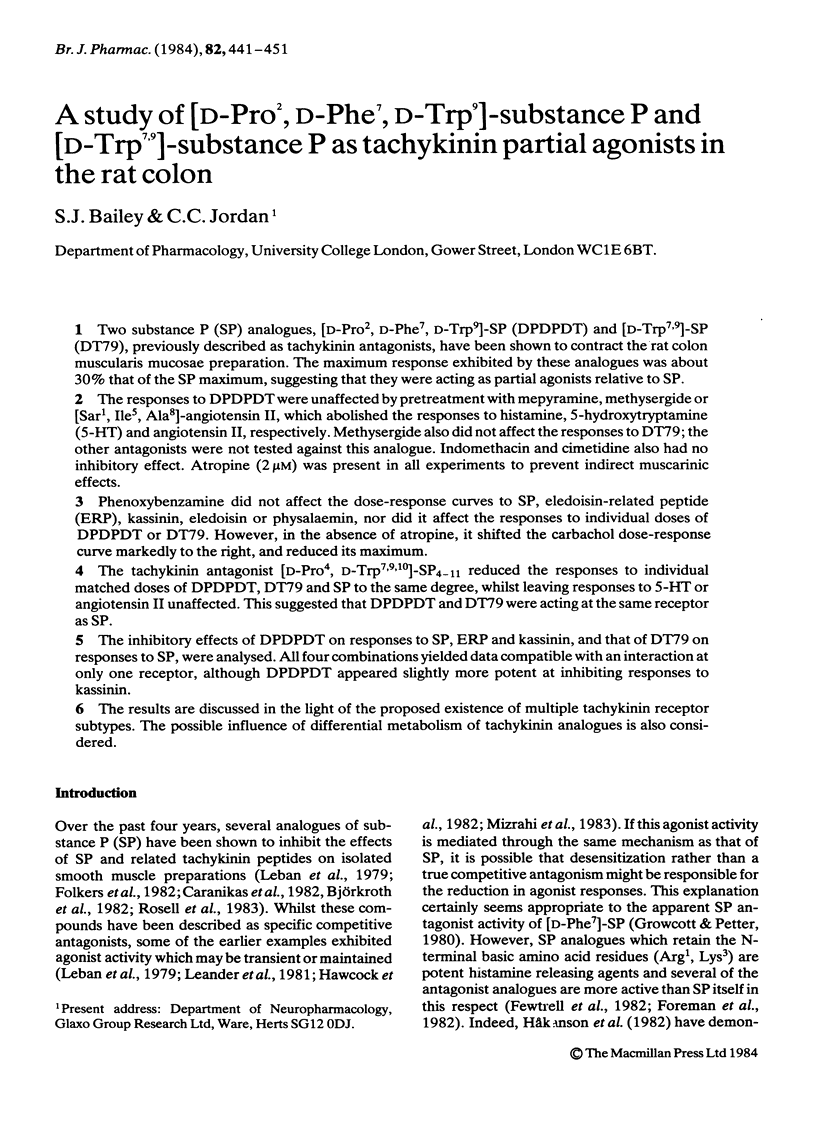

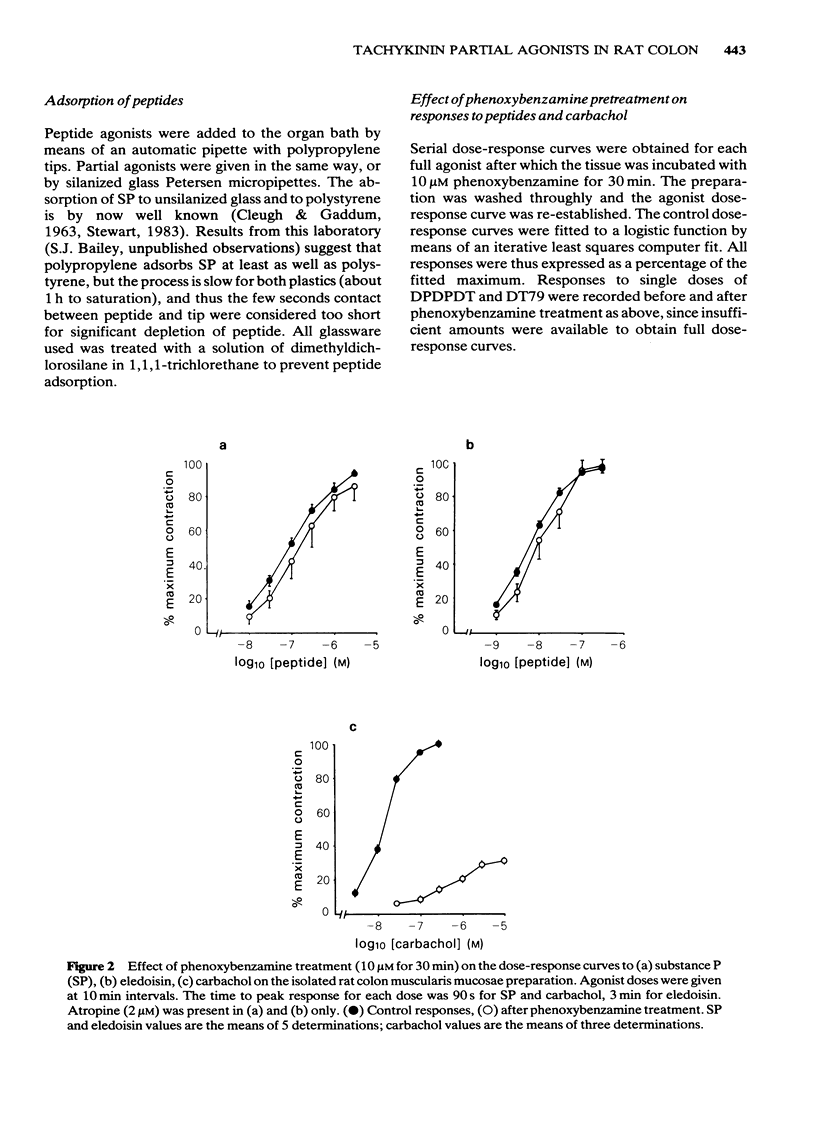
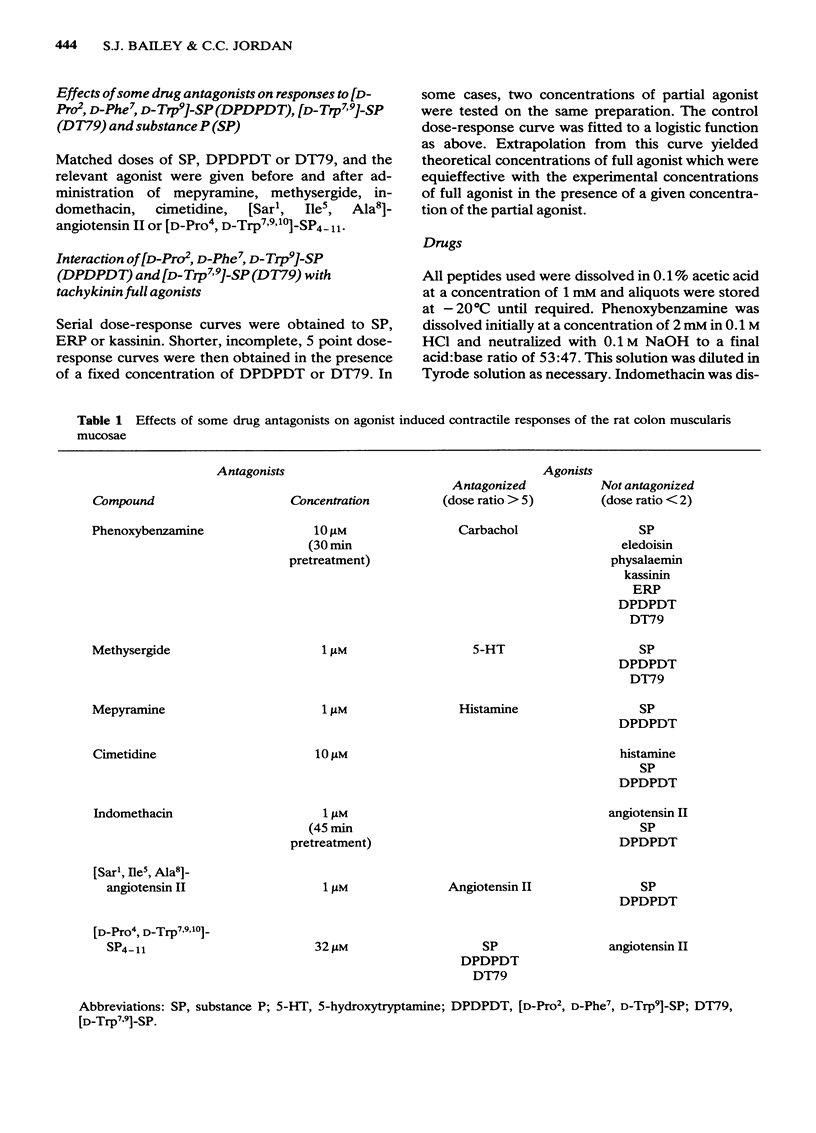
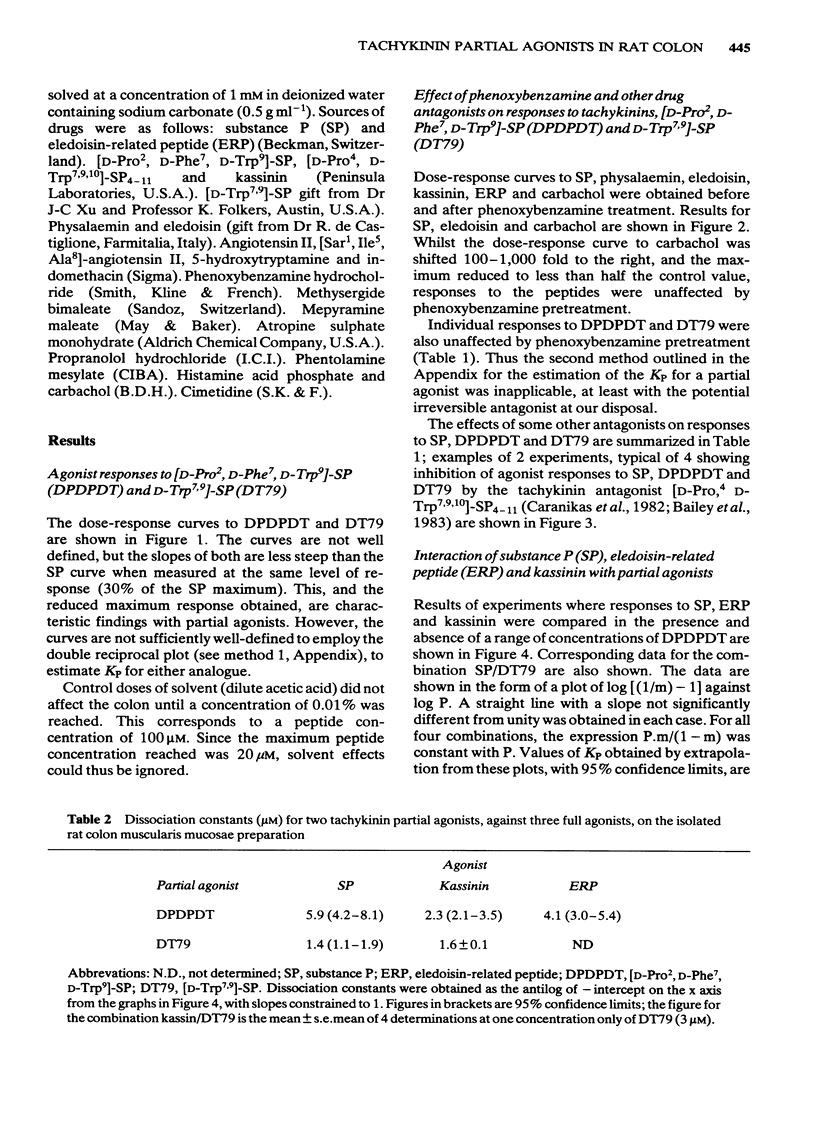

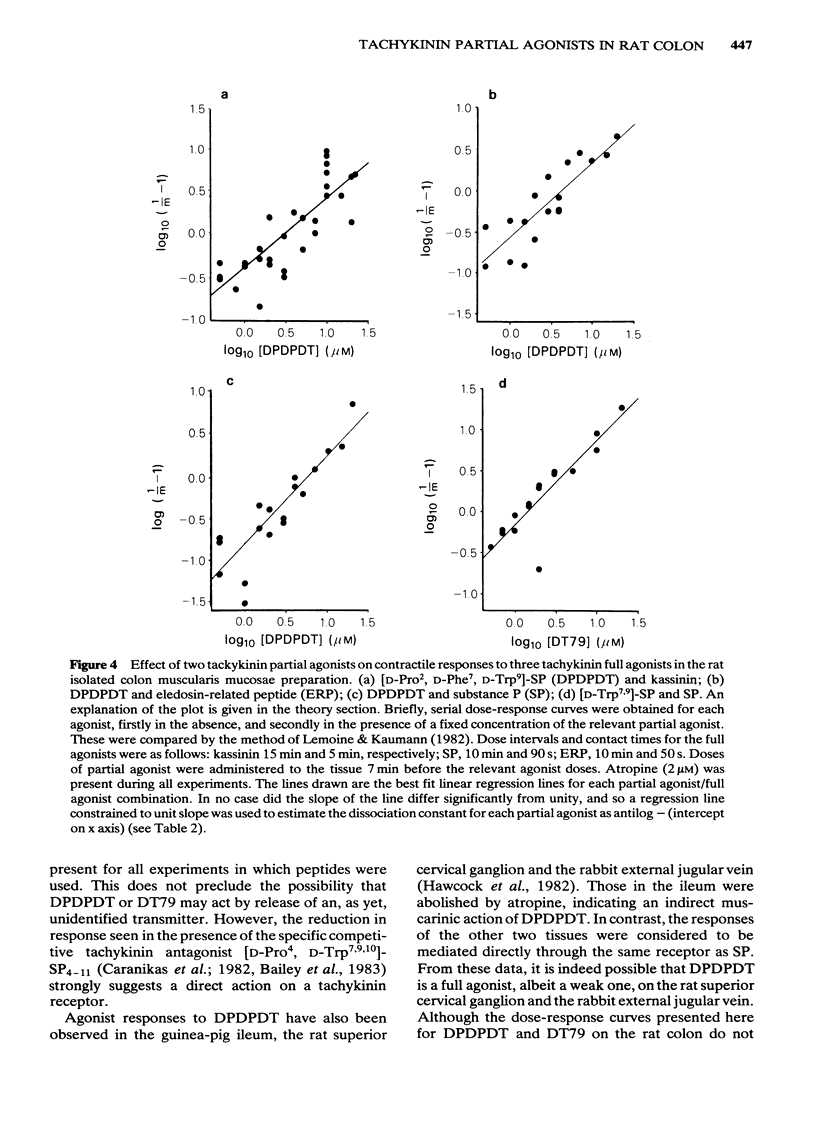
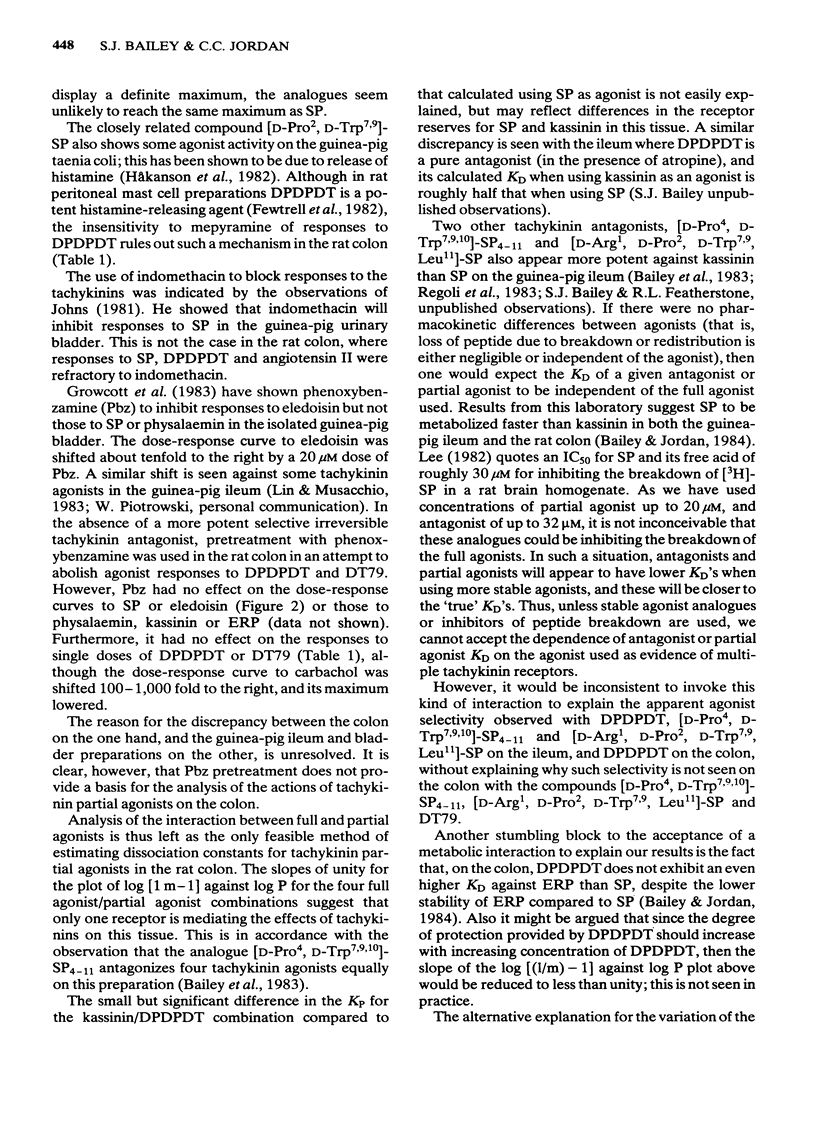
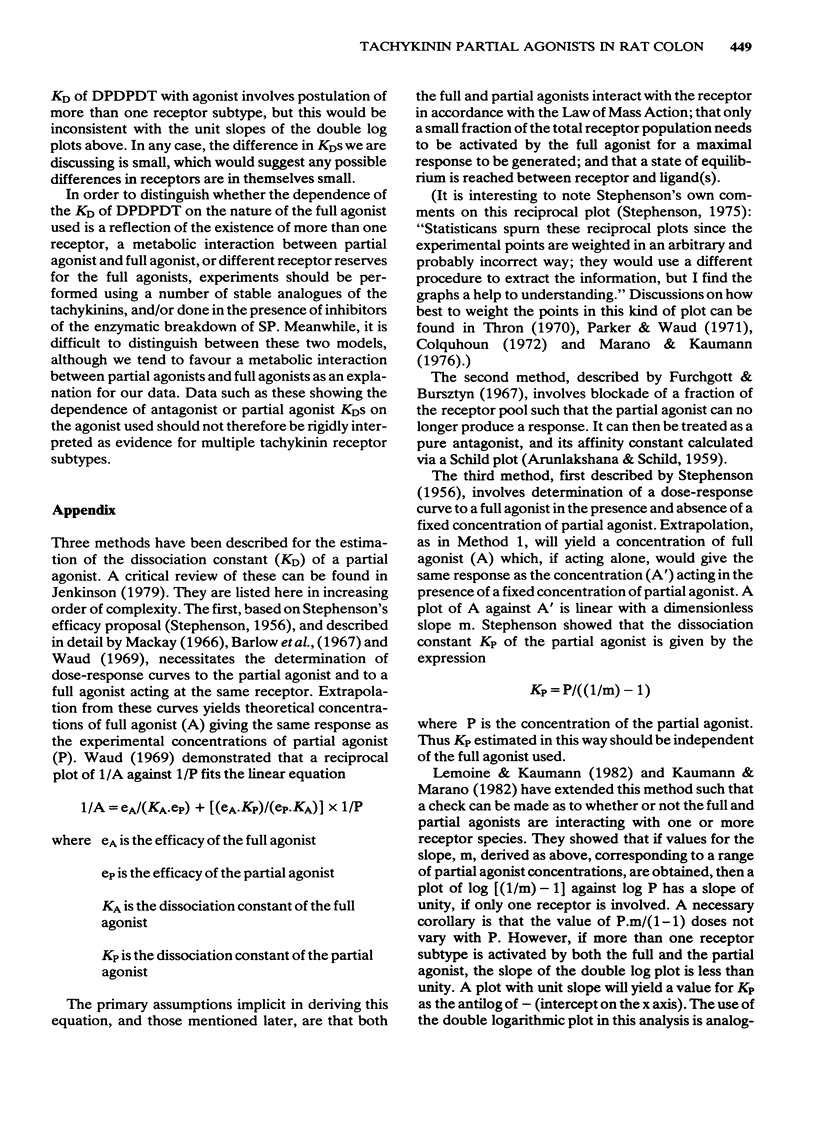
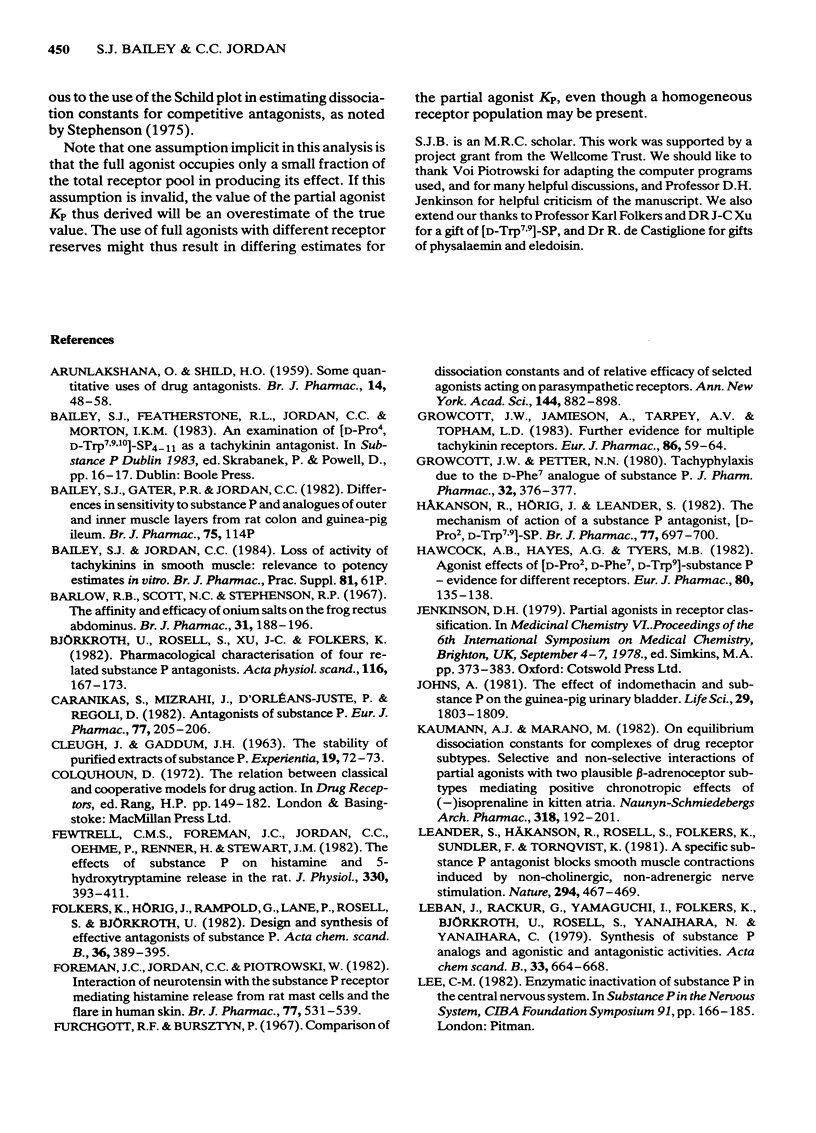
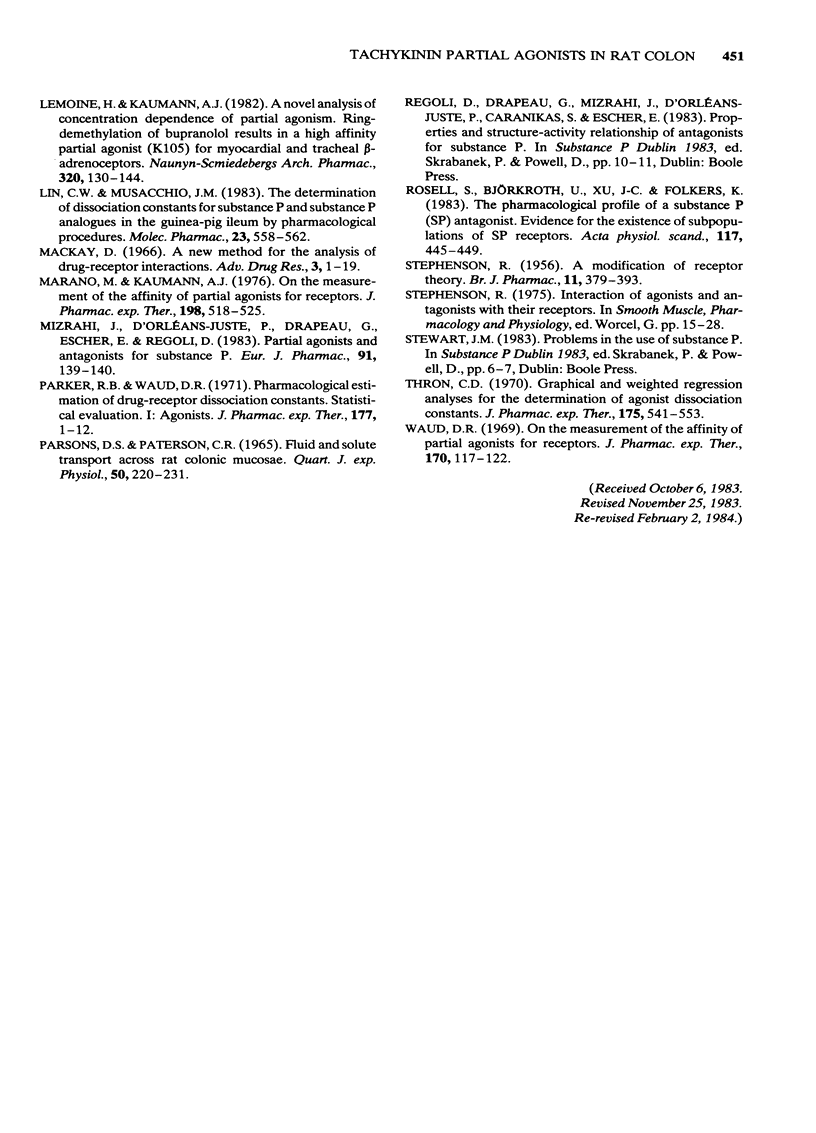
Selected References
These references are in PubMed. This may not be the complete list of references from this article.
- ARUNLAKSHANA O., SCHILD H. O. Some quantitative uses of drug antagonists. Br J Pharmacol Chemother. 1959 Mar;14(1):48–58. doi: 10.1111/j.1476-5381.1959.tb00928.x. [DOI] [PMC free article] [PubMed] [Google Scholar]
- Barlow R. B., Scott N. C., Stephenson R. P. The affinity and efficacy of onium salts on the frog rectus abdominis. Br J Pharmacol Chemother. 1967 Sep;31(1):188–196. doi: 10.1111/j.1476-5381.1967.tb01989.x. [DOI] [PMC free article] [PubMed] [Google Scholar]
- Björkroth U., Rosell S., Xu J. C., Folkers K. Pharmacological characterization of four related substance P antagonists. Acta Physiol Scand. 1982 Oct;116(2):167–173. doi: 10.1111/j.1748-1716.1982.tb07126.x. [DOI] [PubMed] [Google Scholar]
- CLEUGH J., GADDUM J. H. The stability of purified preparations of substance P. Experientia. 1963 Feb 15;19:72–73. doi: 10.1007/BF02148023. [DOI] [PubMed] [Google Scholar]
- Caranikas S., Mizrahi J., D'Orléans-Juste P., Regoli D. Antagonists of substance P. Eur J Pharmacol. 1982 Jan 22;77(2-3):205–206. doi: 10.1016/0014-2999(82)90023-1. [DOI] [PubMed] [Google Scholar]
- Fewtrell C. M., Foreman J. C., Jordan C. C., Oehme P., Renner H., Stewart J. M. The effects of substance P on histamine and 5-hydroxytryptamine release in the rat. J Physiol. 1982 Sep;330:393–411. doi: 10.1113/jphysiol.1982.sp014347. [DOI] [PMC free article] [PubMed] [Google Scholar]
- Folkers K., Hörig J., Rampold G., Lane P., Rosell S., Björkroth U. Design and synthesis of effective antagonists of substance P. Acta Chem Scand B. 1982;36(6):389–395. doi: 10.3891/acta.chem.scand.36b-0389. [DOI] [PubMed] [Google Scholar]
- Foreman J. C., Jordan C. C., Piotrowski W. Interaction of neurotensin with the substance P receptor mediating histamine release from rat mast cells and the flare in human skin. Br J Pharmacol. 1982 Nov;77(3):531–539. doi: 10.1111/j.1476-5381.1982.tb09328.x. [DOI] [PMC free article] [PubMed] [Google Scholar]
- Growcott J. W., Jamieson A., Tarpey A. V., Topham L. D. Further evidence for multiple tachykinin receptors. Eur J Pharmacol. 1982 Dec 17;86(1):59–64. doi: 10.1016/0014-2999(82)90396-x. [DOI] [PubMed] [Google Scholar]
- Growcott J. W., Petter N. N. Tachyphylaxis due to the D-Phe7 analogue of substance P. J Pharm Pharmacol. 1980 May;32(5):376–377. doi: 10.1111/j.2042-7158.1980.tb12945.x. [DOI] [PubMed] [Google Scholar]
- Hawcock A. B., Hayes A. G., Tyers M. B. Agonist effects of [D-Pro2,D-Phe7,D-Trp9]substance P--evidence for different receptors. Eur J Pharmacol. 1982 May 7;80(1):135–138. doi: 10.1016/0014-2999(82)90189-3. [DOI] [PubMed] [Google Scholar]
- Håkanson R., Hörig J., Leander S. The mechanism of action of a substance P antagonist (D-Pro2, D-Trp7,9)-SP. Br J Pharmacol. 1982 Dec;77(4):697–700. doi: 10.1111/j.1476-5381.1982.tb09348.x. [DOI] [PMC free article] [PubMed] [Google Scholar]
- Johns A. The effect of indomethacin and substance P on the guinea pig urinary bladder. Life Sci. 1981 Oct 26;29(17):1803–1809. doi: 10.1016/0024-3205(81)90192-2. [DOI] [PubMed] [Google Scholar]
- Kaumann A. J., Marano M. On equilibrium dissociation constants for complexes of drug-receptor subtypes. Selective and non-selective interactions of partial agonists with two plausible beta-adrenoceptor subtypes mediating positive chronotropic effects of (-)-isoprenaline in kitten atria. Naunyn Schmiedebergs Arch Pharmacol. 1982 Feb;318(3):192–201. doi: 10.1007/BF00500480. [DOI] [PubMed] [Google Scholar]
- Leander S., Håkanson R., Rosell S., Folkers K., Sundler F., Tornqvist K. A specific substance P antagonist blocks smooth muscle contractions induced by non-cholinergic, non-adrenergic nerve stimulation. Nature. 1981 Dec 3;294(5840):467–469. doi: 10.1038/294467a0. [DOI] [PubMed] [Google Scholar]
- Leban J., Rackur G., Yamaguchi I., Folkers K., Björkroth U., Rosell S., Yanaihara N., Yanaihara C. Synthesis of substance P analogs and agonistic and antagonistic activities. Acta Chem Scand B. 1979;33(9):664–668. doi: 10.3891/acta.chem.scand.33b-0664. [DOI] [PubMed] [Google Scholar]
- Lemoine H., Kaumann A. J. A novel analysis of concentration-dependence of partial agonism Ring-demethylation of bupranolol results in a high affinity partial agonist (K 105) for myocardial and tracheal beta-adrenoceptors. Naunyn Schmiedebergs Arch Pharmacol. 1982 Aug;320(2):130–144. doi: 10.1007/BF00506313. [DOI] [PubMed] [Google Scholar]
- Lin C. W., Musacchio J. M. The determination of dissociation constants for substance P and substance P analogues in the guinea pig ileum by pharmacological procedures. Mol Pharmacol. 1983 May;23(3):558–562. [PubMed] [Google Scholar]
- Marano M., Kaumann A. J. On the statistics of drug-receptor constants for partial agonists. J Pharmacol Exp Ther. 1976 Sep;198(3):518–525. [PubMed] [Google Scholar]
- Mizrahi J., D'Orléans-Juste P., Drapeau G., Escher E., Regoli D. Partial agonists and antagonists for substance P. Eur J Pharmacol. 1983 Jul 15;91(1):139–140. doi: 10.1016/0014-2999(83)90376-x. [DOI] [PubMed] [Google Scholar]
- PARSONS D. S., PATERSON C. R. FLUID AND SOLUTE TRANSPORT ACROSS FAT COLONIC MUCOSA. Q J Exp Physiol Cogn Med Sci. 1965 Apr;50:220–231. doi: 10.1113/expphysiol.1965.sp001784. [DOI] [PubMed] [Google Scholar]
- Parker R. B., Waud D. R. Pharmacological estimation of drug-receptor dissociation constants. Statistical evaluation. I. Agonists. J Pharmacol Exp Ther. 1971 Apr;177(1):1–12. [PubMed] [Google Scholar]
- Rosell S., Björkroth U., Xu J. C., Folkers K. The pharmacological profile of a substance P (SP) antagonist. Evidence for the existence of subpopulations of SP receptors. Acta Physiol Scand. 1983 Mar;117(3):445–449. doi: 10.1111/j.1748-1716.1983.tb00019.x. [DOI] [PubMed] [Google Scholar]
- STEPHENSON R. P. A modification of receptor theory. Br J Pharmacol Chemother. 1956 Dec;11(4):379–393. doi: 10.1111/j.1476-5381.1956.tb00006.x. [DOI] [PMC free article] [PubMed] [Google Scholar]
- Thron C. D. Graphical and weighted regression analyses for the determination of agonist dissociation constants. J Pharmacol Exp Ther. 1970 Nov;175(2):541–553. [PubMed] [Google Scholar]
- Waud D. R. On the measurement of the affinity of partial agonists for receptors. J Pharmacol Exp Ther. 1969 Nov;170(1):117–122. [PubMed] [Google Scholar]


